What is a SPIFF in Sales? 23 Powerful SPIFFs to Boost Performance in 2025

Want to know the truth about sales motivation that most leaders miss?
SPIFFs aren't just another bonus - they're the difference between hitting your targets and blowing past them.
I understood the importance of getting SPIIFs right during a quarter (years ago) when our team was struggling with a new product launch.
Sales were flat, energy was low, and we needed a spark. We implemented a targeted SPIFF program, and within weeks, the product went from our worst performer to our best.
That's the power of a well-designed SPIFF.
Sales bonuses have always been part of the game, but SPIFFs hold a special place in the toolkit of effective sales leaders. They're not just about throwing extra money at your team - they're about strategically guiding your sales force toward the specific outcomes your business needs right now.
In this guide, we'll break down everything kind of SPIFF that you will ever need. We will dive into what they are, why they matter, and how to implement them without the common pitfalls I've seen derail even the best incentive programs.
The harsh reality? Most companies get SPIFFs wrong.
They treat them as a "nice to have" rather than the strategic lever they truly are. They set them up without clear measurement, without attribution models, without real thought about ROI.
Its time to move past the facade and treat these programs with the strategic importance they deserve.
Ready to transform how your team sells? Let's dive in.
What is a SPIFF in Sales?
SPIFFs stand for 'Sales Performance Incentive Fund', however, it is also known as 'Special Purpose Incentive Fund. They are sales bonuses implemented to drive specific outcomes in sales, unlike commissions which are given out on making sales. Hence, SPIFFs are paid on top of the usual sales commissions for a deal.
For example, a company may implement a SPIFF to be paid out to a salesperson if they can negotiate an upfront payment with a client. Other such usage examples for SPIFFs are explained further below in this blog.
The best part about SPIFFs is that they can be used in many different ways, depending on what the company needs. They have the power to drive specific short-term goals and drive sales reps' motivation.
Want to make sales reps focus more on a newly launched product?
Want to encourage multi-year deals?
Want to encourage self-generated deals?
All these outcomes can be driven by implementing SPIFFs for them.
How to Use SPIFFs?
Every SPIFF has a clear reason behind it. They are particularly ideal for giving a short-term boost to specific sales goals, making them a valuable tool for addressing immediate business needs. They can be paired with other sales incentives to double down on specific goals while still ensuring that salespersons have enough incentive to focus on sales.
Companies use them for specific reasons:
- Guiding Sales Teams: SPIFFs help point salespeople in the right direction. For example, if a company has a new product, SPIFFs can give extra money for every sale of that product, leading salespeople to focus more on selling the newer product.
- Meeting Short-Term Goals: Need to hit a target in the next month or quarter? SPIFFs can give that extra push, encouraging salespeople to work harder and meet those targets.
- Promoting New Products or Services: When there's a new product, SPIFFs make sure the sales team focuses on it. Controlling the focus of sales teams is one of the major ways in which SPIFFs are used.
SPIFF vs Commission: Key Differences Explained
Many sales leaders confuse SPIFFs with commissions or use them interchangeably. Understanding their differences is crucial for effective implementation:
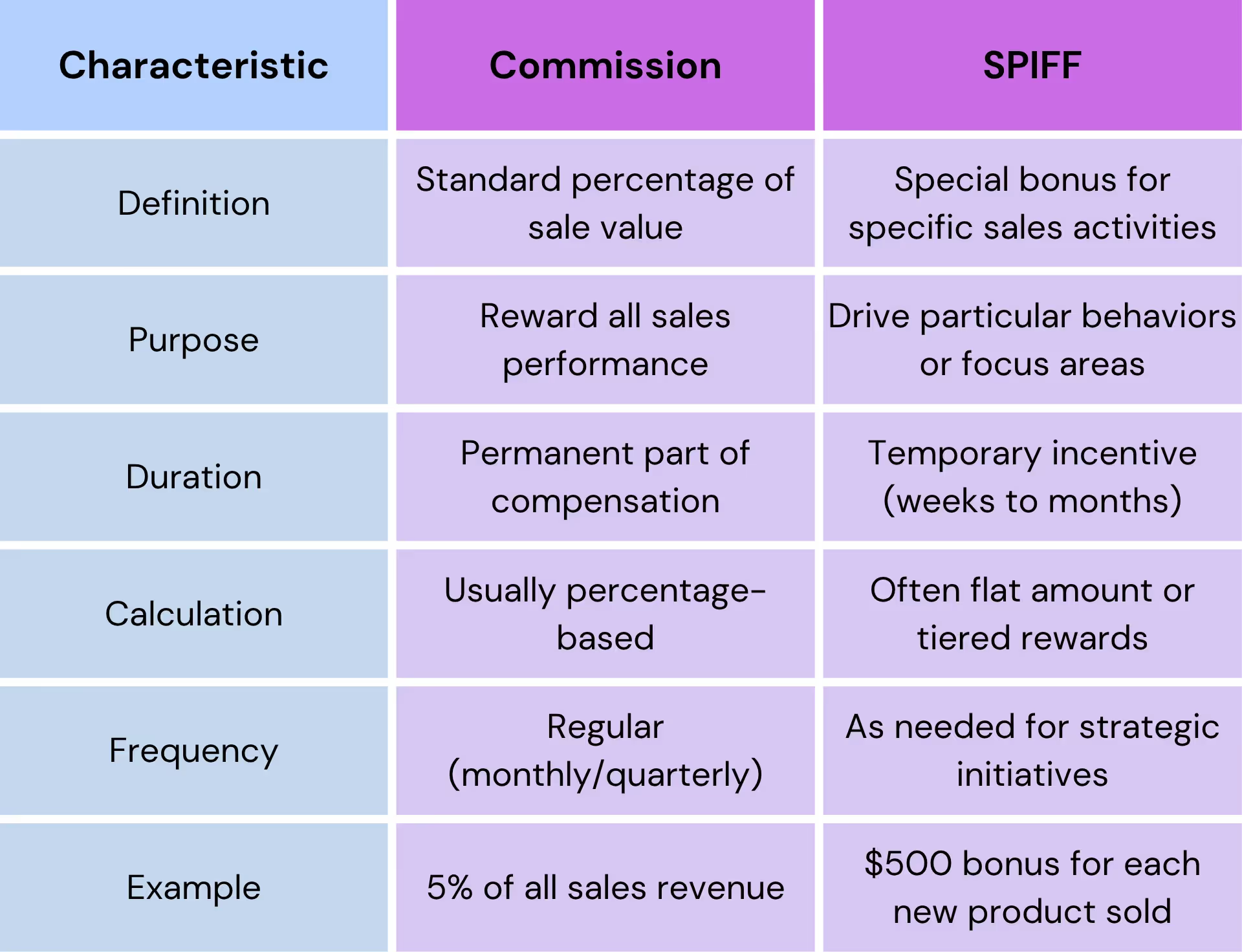
5 Key Benefits of Implementing SPIFFs
When designed correctly, SPIFFs offer significant advantages beyond simply boosting sales numbers:
1. Targeted Motivation Without Long-term Commitment
SPIFFs provide a surge of motivation for specific objectives without altering your permanent compensation structure. This flexibility lets you respond to changing business needs without locking into long-term financial commitments.
2. Rapid Behavior Change
Need your team to pivot quickly? SPIFFs can change sales behavior immediately, unlike training programs or culture shifts that take months to implement.
3. Data-Rich Experimentation
Each SPIFF program serves as a real-world experiment, generating valuable data about what motivates your specific sales team and which incentives drive the best ROI.
4. Energy Boost During Critical Periods
SPIFFs inject renewed enthusiasm during traditionally challenging times like quarter-end pushes, summer slumps, or holiday seasons when attention might otherwise wane.
5. Healthy, Focused Competition
Well-structured SPIFFs create positive competition around specific metrics, driving performance while keeping the team aligned toward common goals rather than competing at cross-purposes.
Types of SPIFF Programs That Drive Results
Sales SPIFFs come in various forms, each designed to address different business needs:
Monetary SPIFFs
These cash-based incentives remain the most common and effective SPIFF type. Examples include:
- Fixed Amount SPIFFs: Flat dollar amounts for achieving specific goals
- Tiered SPIFFs: Increasing rewards as performance exceeds different thresholds
- Percentage SPIFFs: Additional commission percentage for strategic products
- Pool-Based SPIFFs: Shared rewards distributed among top performers
Non-Monetary SPIFFs
While cash is king, non-monetary incentives can sometimes drive even more enthusiasm:
- Experience SPIFFs: Travel, events, or unique experiences
- Recognition SPIFFs: Public acknowledgment, awards, or status symbols
- Merchandise SPIFFs: Technology, luxury items, or other desirable goods
- Time-Off SPIFFs: Additional paid time off for achieving targets
Team vs. Individual SPIFFs
Strategic consideration should be given to whether your SPIFF targets:
- Individual Performance: Driving personal accountability and effort
- Team Performance: Encouraging collaboration and collective achievement
- Hybrid Approach: Combining both to balance individual drive with teamwork
How Do SPIFFs Work in Your Sales Compensation Plan?
SPIFFs function as tactical tools within your broader sales compensation strategy. They provide the flexibility to influence specific sales behaviors without restructuring your entire commission plan.
The Role of SPIFFs in Sales Strategy
Every SPIFF should have a clear strategic purpose:
- Guiding Sales Teams: SPIFFs direct your team's focus where you need it most. For example, if you've just launched a new product line, a SPIFF can incentivize your team to prioritize it over more familiar offerings.
- Meeting Short-Term Goals: Need to hit a specific revenue target this quarter? SPIFFs can provide that extra motivation for your team to push harder toward concrete, time-bound objectives.
- Promoting Strategic Initiatives: When company priorities shift, SPIFFs help realign your sales team quickly without waiting for the next commission plan update.
23 Effective Sales SPIFF Program Examples for your Business
Let’s take a look at some practical examples and understand ways to utilize SPIFFs and improve the performance of your sales teams.
#1: Product SPIFF
Imagine you're a company that has just launched a new software tool. You want your sales team to prioritize this product over others, at least for the initial launch phase when market penetration is low. This cannot be done through normal base commissions as the older products are easier to sell. This is where a Product SPIFF comes in handy.
Real-life Use Case:
Consider a company like Adobe launching a new graphic design tool. They already have a range of products, but this new tool needs special attention to gain traction in the market.
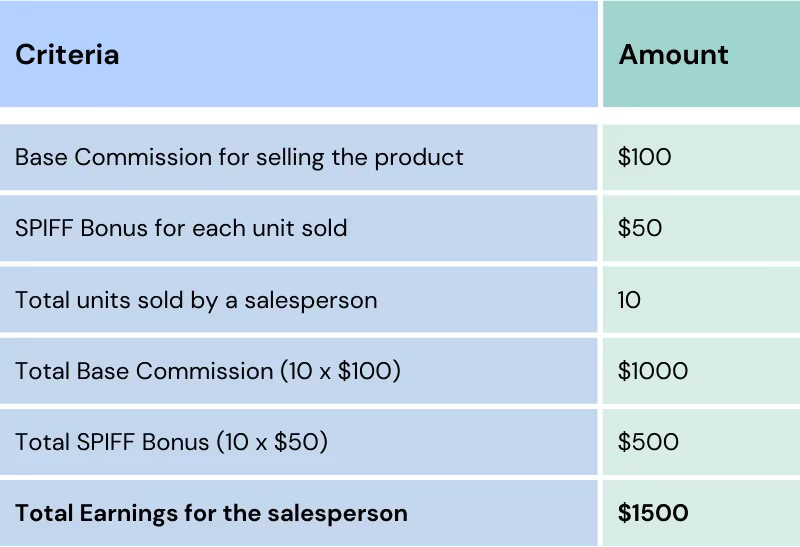
By introducing this SPIFF, the salesperson earns an extra $500 for selling 10 units of the new product, making it more attractive for them to push this product.
#2: Strategic Account Bonus
Big clients or strategic accounts often bring more revenue and prestige to a company. Closing deals with such accounts can be challenging but highly rewarding.
Real-life Use Case:
Think of a startup that offers cloud storage solutions. Landing a contract with a big corporation like IBM would be a significant win.
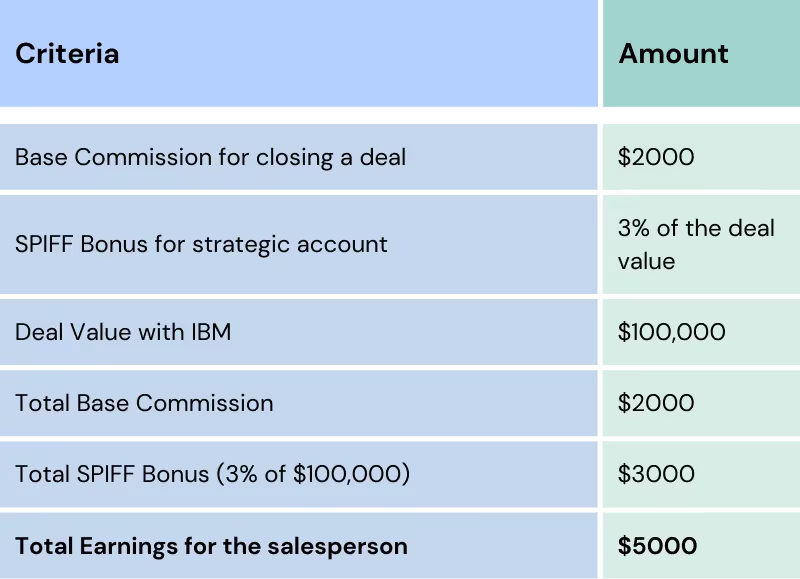
With the SPIFF, the salesperson gets an additional $3000 for closing a strategic account, making them more inclined to pursue such high-value deals.
#3: Milestone Bonus
Sales targets are set for a reason. They guide salespeople and give them something to aim for. But what if a salesperson goes above and beyond? A Milestone Bonus rewards such overachievers.
Real-life Use Case:
A car dealership sets a quarterly target of selling 50 cars for each salesperson. One particular salesperson manages to sell 70.
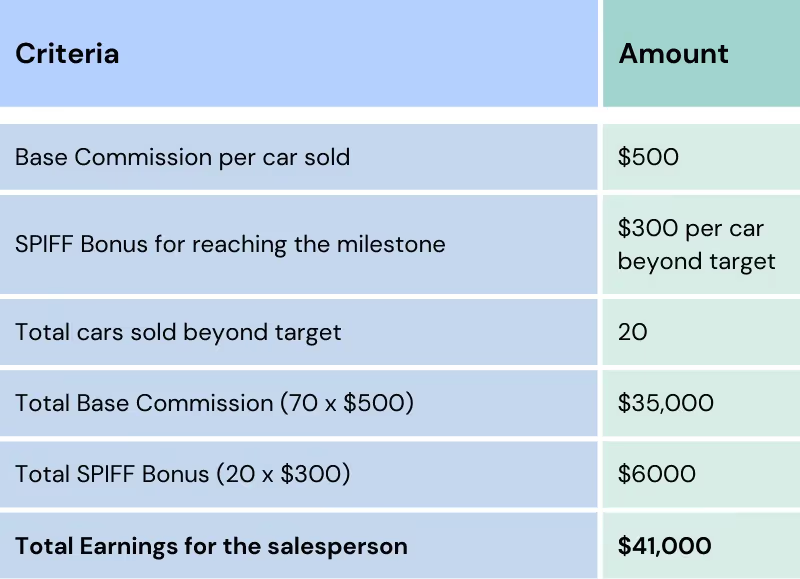
By introducing a Milestone Bonus, the salesperson is encouraged to not just meet but exceed their targets, earning an extra $6000 for their exceptional performance.
#4: Upfront Payments
Cash flow is crucial for businesses, especially startups. Getting customers to pay upfront can significantly improve a company's financial health. An Upfront Payment SPIFF motivates salespeople to negotiate such terms.
Real-life Use Case:
A SaaS company offers monthly and yearly subscription plans. While monthly plans provide steady income, yearly upfront payments can help the company invest in immediate growth opportunities.
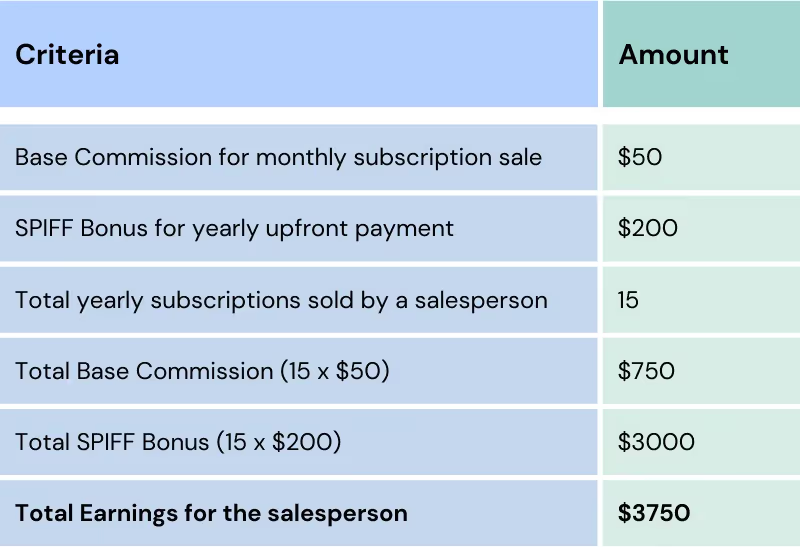
By pushing yearly subscriptions, the salesperson can earn significantly more, and the company benefits from immediate cash flow.
#5: Multi-Year Deals
Long-term commitments from customers ensure steady revenue and reduce the cost of sales renewals. Multi-Year Deal SPIFFs reward salespeople for securing longer-term contracts.
Real-life Use Case:
A cybersecurity firm offers annual licenses for its software. A three-year contract not only ensures a longer commitment but also reduces the chances of the client switching to a competitor.

Securing longer-term contracts can significantly boost a salesperson's earnings, making it a win-win for both the salesperson and the company.
#6: Adoption/Usage SPIFF
For many products, especially software, just selling isn't enough. Actual usage by customers ensures renewals and reduces churn. This SPIFF encourages salespeople to not just sell but ensure customers use the product.
Real-life Use Case:
A company selling project management tools wants to ensure that teams are actively using their platform, which would likely lead to renewals and upsells.
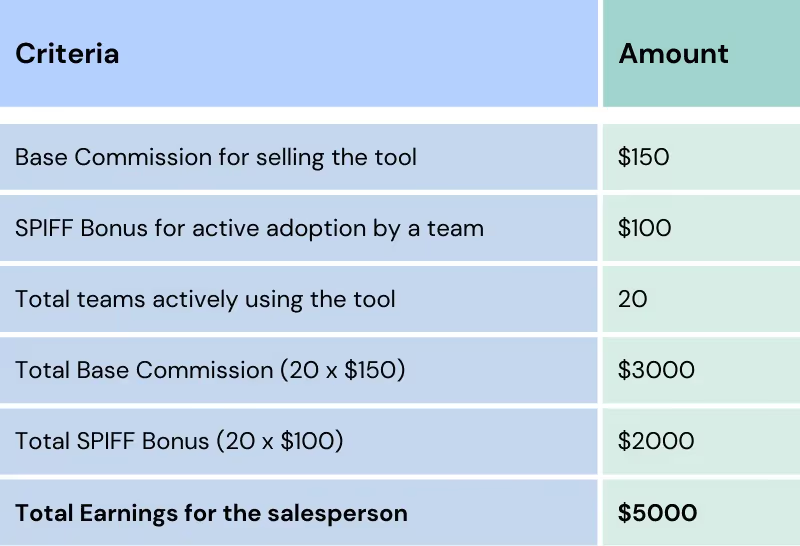
By ensuring that teams are actively using the tool, the salesperson can earn an additional bonus, and the company benefits from satisfied customers.
#7: Customer/Partner Referral
Referrals are a goldmine in sales. A recommendation from a trusted source can significantly shorten the sales cycle. This SPIFF encourages salespeople to tap into their networks and get warm leads.
Real-life Use Case:
A cloud services company wants to expand its clientele. Instead of cold calling, they decide to leverage the networks of their salespeople and existing clients.
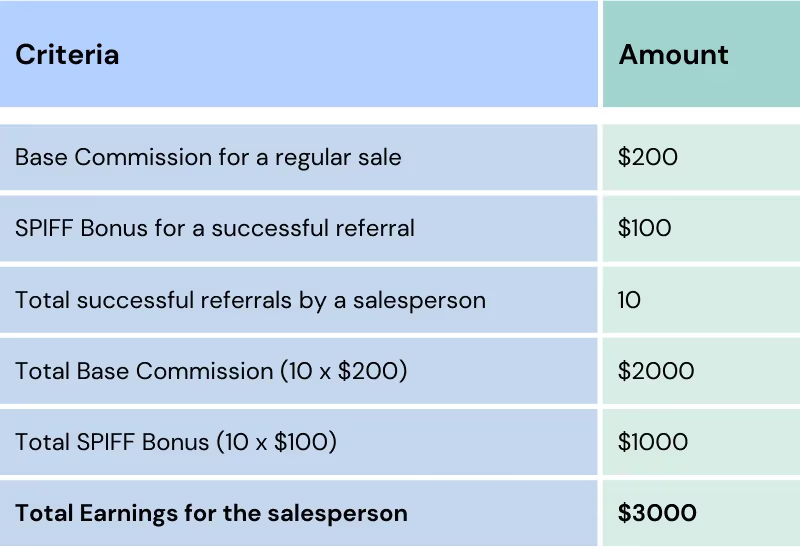
By bringing in warm leads through referrals, the salesperson can earn an additional bonus, and the company benefits from easier sales conversions.
#8: Deal Size
Bigger deals mean more revenue. This SPIFF motivates salespeople to aim higher and close larger deals.
Real-life Use Case:
A furniture supplier wants to secure contracts with larger offices. Instead of selling to small offices, they incentivize salespeople to target corporate offices and big businesses.
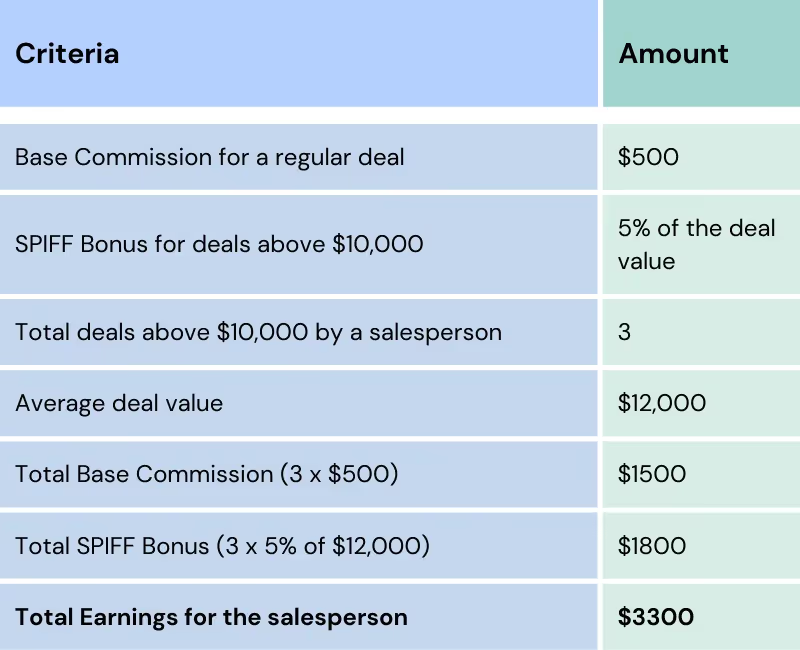
By targeting and closing bigger deals, the salesperson can significantly boost their earnings, and the company enjoys larger contracts.
#9: Self-Generated Deal
Initiative and proactiveness are valuable traits in sales. This SPIFF rewards salespeople who don't just rely on inbound leads but go out and create opportunities themselves.
Real-life Use Case:
A digital marketing agency wants to expand its client base. Instead of waiting for clients to come to them, they reward salespeople who actively seek out and close new business.
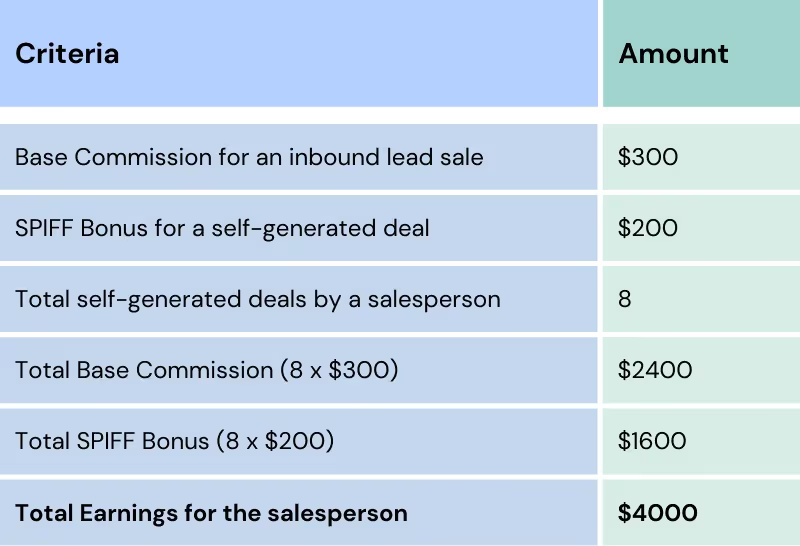
By taking the initiative and bringing in new business on their own, the salesperson can earn a substantial bonus, and the company benefits from expanded clientele.
#10: Year-over-Year Increment
Consistent growth is vital for any business. This SPIFF rewards salespeople who not only maintain their performance but show improvement year after year.
Real-life Use Case:
A health supplement company wants to see growth in its product sales every year. They decide to reward salespeople who surpass their previous year's performance.
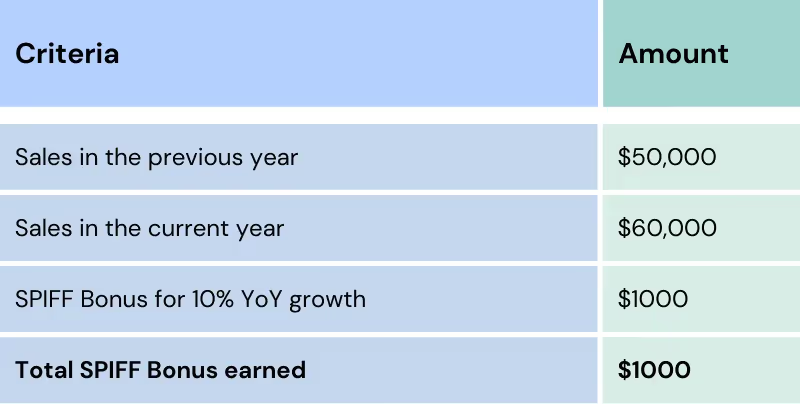
By achieving a 10% growth compared to the previous year, the salesperson earns an additional bonus, motivating them to keep pushing boundaries.
#11: Customer Advocacy
Happy customers are the best brand ambassadors. This SPIFF encourages salespeople to gather positive testimonials and case studies, which can be powerful sales tools.
Real-life Use Case:
A software development platform wants to showcase its success stories. They incentivize salespeople to collect positive feedback and detailed case studies from satisfied clients.

By collecting valuable testimonials, the salesperson not only earns an additional bonus but also provides the company with powerful marketing material.
#12: Product Combo
Sometimes, selling products in combination can provide more value to the customer and increase the deal size. This SPIFF rewards salespeople for such bundled sales
Real-life Use Case:
A tech store wants to promote the sale of laptops along with software packages. They offer a SPIFF for every combo sale.
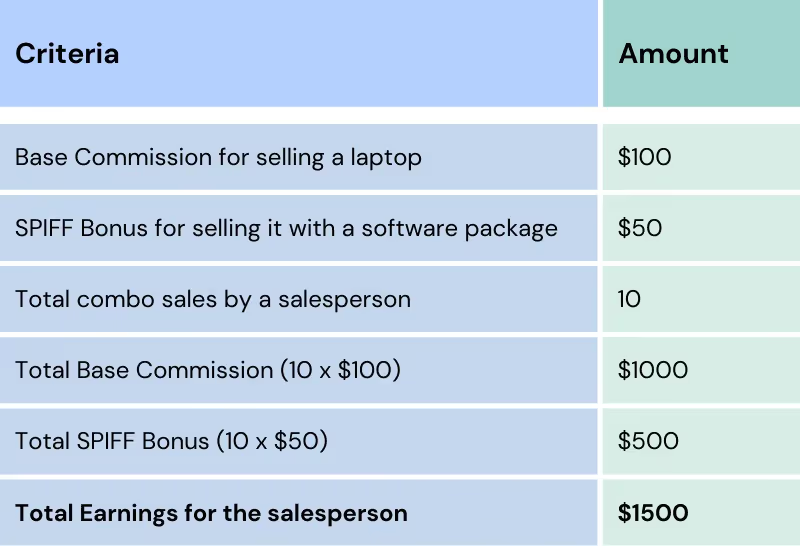
By promoting and selling product combos, the salesperson can boost their earnings, and customers get a better overall package.
#13: Training & Certification (MBO)
A well-informed salesperson can sell better. This SPIFF encourages salespeople to upskill by completing training and certifications.
Real-life Use Case:
A cybersecurity firm rolls out a new product. They offer a SPIFF to salespeople who complete a certification course related to the new product.

By investing time in training, the salesperson not only becomes better equipped to sell but also earns an additional bonus.
#14: Reverse SPIFFs
While it's essential to close deals, it's equally important to maintain profitability. This SPIFF is a bit different – it reduces commissions if salespeople offer too high discounts, ensuring they prioritize the company's bottom line.
Real-life Use Case:
A luxury watch brand doesn't want to dilute its brand value by offering high discounts. They introduce a Reverse SPIFF to discourage excessive discounting.

By introducing a Reverse SPIFF, salespeople are more cautious about offering high discounts, ensuring the brand's value is maintained.
#15: Fast Start Bonus
The beginning of a quarter or fiscal year is crucial. A strong start can set the tone for the rest of the period. This SPIFF rewards salespeople who hit the ground running.
Real-life Use Case:
A publishing house wants to ensure that their new book releases get strong initial sales. They offer a bonus for salespeople who achieve a certain percentage of their quota in the first month.

By achieving a significant portion of their quota early on, the salesperson not only sets a positive pace but also earns an additional bonus.
#16: Renewal SPIFF
Retaining existing customers is often more cost-effective than acquiring new ones. This SPIFF rewards salespeople for ensuring customers renew their contracts, emphasizing customer loyalty.
Real-life Use Case:
A software-as-a-service (SaaS) company knows the value of customer retention. They offer a bonus for salespeople who secure renewals, especially for long-term contracts.

By focusing on renewals, the salesperson ensures a steady stream of revenue for the company and earns a handsome bonus for their efforts.
#17: Cross-Selling SPIFF
Existing customers can be introduced to other products or services, increasing the overall deal value. This SPIFF rewards salespeople who effectively cross-sell.
Real-life Use Case:
A gym, apart from its regular memberships, offers specialized fitness classes and diet consultation. They introduce a SPIFF to encourage salespeople to promote these additional services to existing members.
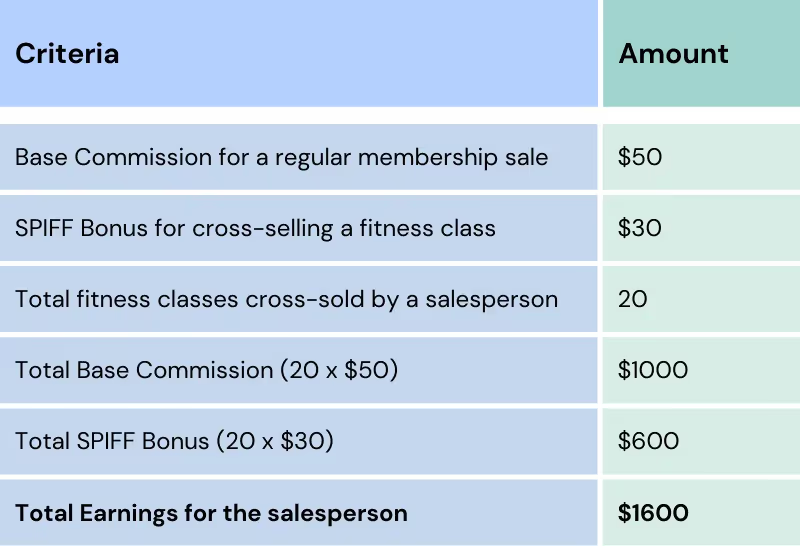
By promoting additional services to existing members, the salesperson can significantly boost their earnings, and members get a more holistic fitness solution.
#18: Bundling SPIFF
Bundling products or services can increase the overall deal size and provide more comprehensive solutions to customers. This SPIFF rewards salespeople for promoting bundled offers.
Real-life Use Case:
A tech store offers a laptop, mouse, keyboard, and headphones as a bundle. The idea is to provide a complete setup for customers, especially those working from home.
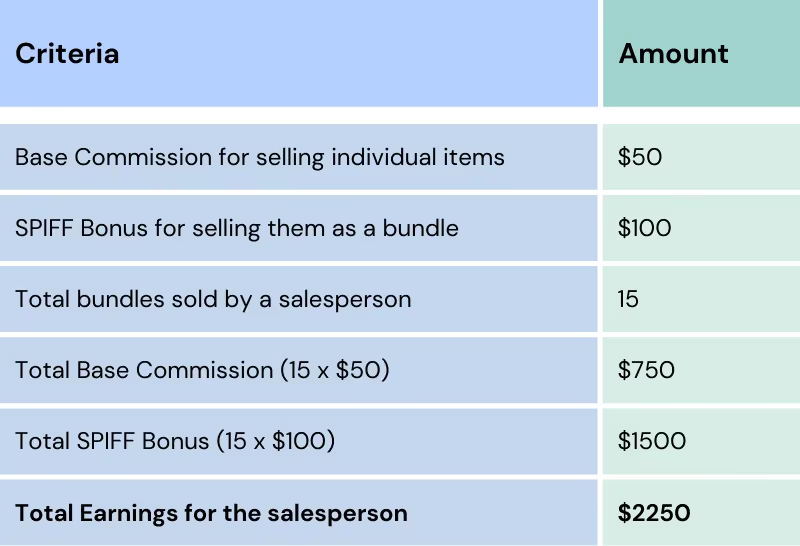
By promoting the bundled offer, the salesperson can earn a significant bonus, and customers get a complete package at a better price.
#19: Expedited Deal Closure
Time-sensitive deals or promotions can create urgency and speed up the sales process. This SPIFF rewards salespeople who close deals within a specific timeframe.
Real-life Use Case:
A travel agency offers early bird discounts for summer vacation packages. They introduce a SPIFF for salespeople who secure bookings within the first two weeks of the promotion.
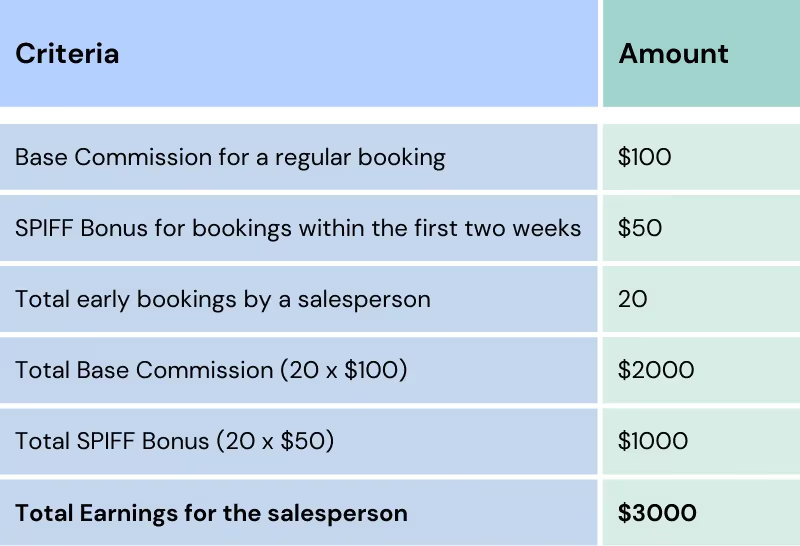
By focusing on early bookings, the salesperson can earn an additional bonus, and the travel agency ensures a steady influx of customers well before the peak season.
#20: New Market SPIFF
Breaking into a new market or demographic can be challenging but rewarding. This SPIFF offers additional incentives for sales made in a specific new segment.
Real-life Use Case:
A skincare brand, popular among women, wants to introduce products for men. They offer a SPIFF to salespeople who promote and sell these new products to male customers.

By targeting and selling to the new demographic, the salesperson can significantly boost their earnings, and the brand expands its customer base.
#21: Reactivation SPIFF
Re-engaging dormant accounts or customers who haven't purchased in a while can be a goldmine. This SPIFF rewards salespeople who focus on reactivation.
Real-life Use Case:
A magazine subscription service notices that many past subscribers haven't renewed in over a year. They introduce a SPIFF for salespeople who can bring these subscribers back.
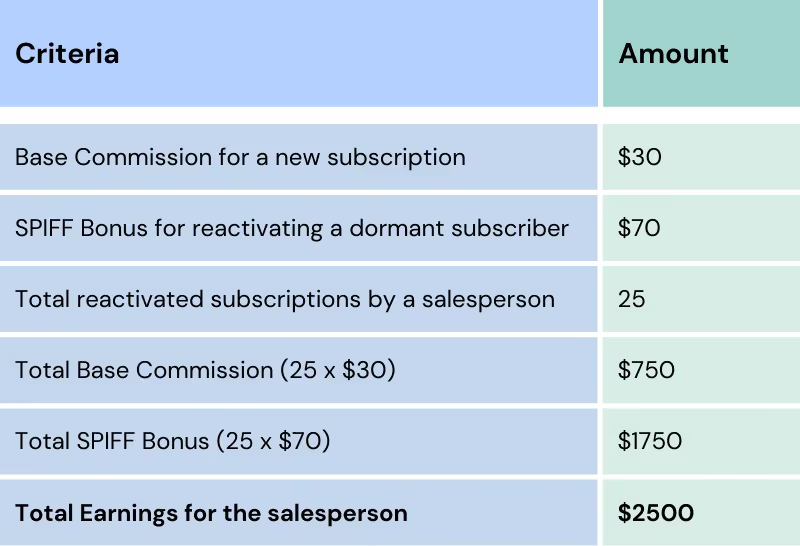
By focusing on reactivating past subscribers, the salesperson can earn a substantial bonus, and the magazine regains its readership.
#22: High Margin Product SPIFF
Some products offer higher profit margins than others. By incentivizing salespeople to focus on these products, companies can boost their profitability.
Real-life Use Case:
An electronics store identifies that certain premium headphones offer a higher profit margin compared to other products. They introduce a SPIFF to promote the sale of these headphones.
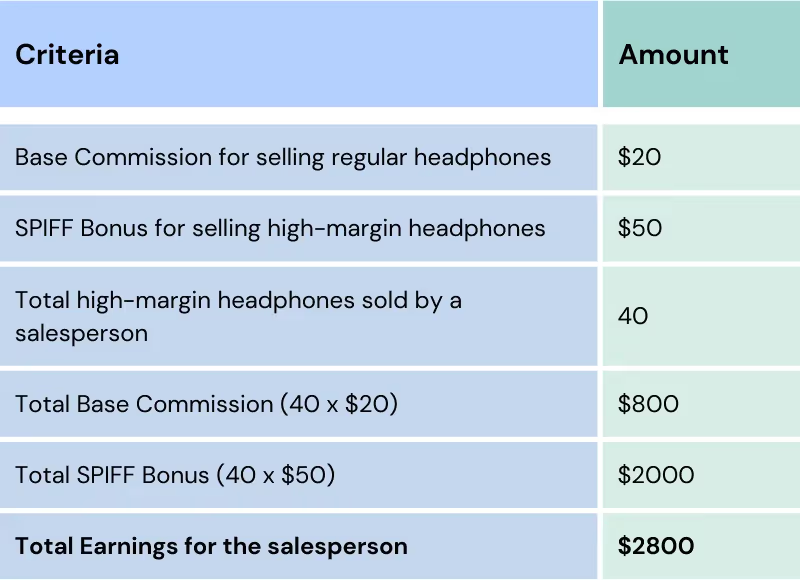
By promoting and selling high-margin products, the salesperson can significantly boost their earnings, and the store enjoys higher profitability.
#23: Contract Extension SPIFF
Extending existing contracts ensures a longer revenue stream and strengthens customer relationships. This SPIFF rewards salespeople for getting customers to commit for a longer period.
Real-life Use Case:
A cloud storage provider wants to ensure long-term commitments from its clients. They offer a SPIFF for salespeople who can get clients to extend their existing contracts.

By focusing on contract extensions, the salesperson ensures a steady revenue stream for the company and earns a handsome bonus for their efforts.
🔔 Must read: How can we motivate and incentivize our sales team to achieve their targets and goals?
How to Create an Effective SPIFF Program
1. Start with Clear, Measurable Goals
Begin by defining exactly what you want your SPIFF program to achieve. Your objectives should be:
- Specific: Target precise metrics (e.g., "Increase new product sales by 30%")
- Measurable: Ensure you can track progress accurately
- Time-bound: Set a defined timeframe (typically 1-3 months for most SPIFFs)
- Aligned: Connected directly to current business priorities
Ask yourself: "What specific behavior change would make the biggest impact on our business right now?"
2. Design a Simple Structure
Keep your SPIFF program straightforward and easy to understand with these elements:
- Clear Reward Values: Determine appropriate incentive amounts that motivate without breaking your budget
- Achievement Criteria: Set unambiguous thresholds for earning rewards
- Transparent Rules: Ensure everyone understands exactly how the program works
- Attainable Yet Challenging Targets: Find the sweet spot between too easy and impossible
Example Structure: "Earn $300 for each new product demo that converts to a sale during May and June, with an additional $1,000 bonus for sales representatives who convert 10+ demos."
3. Plan Your Budget Carefully
Before launching, calculate your potential financial exposure:
- Maximum Payout Scenario: What happens if everyone maximizes the SPIFF?
- Expected Performance Distribution: What's the realistic participation rate?
- ROI Analysis: Will the additional revenue justify the incentive cost?
- Budget Caps: Consider setting upper limits if needed
Pro Tip: Include a 10-15% buffer in your budget to account for unexpected overperformance.
4. Communicate Clearly and Frequently
Launch your program with comprehensive communication:
- Kickoff Meeting: Introduce the program with energy and clarity
- Written Documentation: Provide detailed guidelines and examples
- Visual Aids: Create simple charts showing how rewards are calculated
- Regular Updates: Keep the program visible throughout its duration
Key Communication Elements:
- Program duration and key dates
- Exact qualification criteria
- Reward structure and payment timing
- Real examples showing how it works
5. Set Up Proper Tracking Systems
Implement robust monitoring tools to track performance:
- Real-Time Dashboards: Make progress visible to participants
- Regular Reporting: Schedule updates at appropriate intervals
- Individual Tracking: Help each team member monitor their own progress
- Transparent Metrics: Focus on measurements directly tied to program goals
Important: Ensure your CRM or sales management system can accurately track the specific metrics your SPIFF is targeting.
6. Gather Feedback and Adjust
Remain flexible throughout the program:
- Check-In Meetings: Solicit input from participants
- Monitor for Unintended Consequences: Watch for gaming or negative side effects
- Make Adjustments: Be willing to fine-tune if needed
- Document Learnings: Record insights for future programs
7. Pay Rewards Promptly
Nothing kills motivation faster than delayed recognition:
- Quick Processing: Pay SPIFFs as soon as goals are achieved
- Clear Communication: Keep participants informed about payment timing
- Celebration: Recognize achievements publicly when appropriate
- Documentation: Maintain detailed records of all payments
Common SPIFF Program Mistakes and How to Avoid Them
Even well-intentioned SPIFF programs can go wrong. Here are the most common pitfalls and how to avoid them:
Mistake #1: Creating Distraction from Core Goals
The Problem: When SPIFFs become more rewarding than the core compensation plan, salespeople may neglect primary objectives.
Solution:
- Limit SPIFFs to 15-20% of total compensation potential
- Ensure SPIFF goals align with broader sales objectives
- Monitor core KPIs during SPIFF periods to detect unwanted shifts
Mistake #2: Overemphasizing Certain Products
The Problem: While SPIFFs can successfully drive focus to specific products, they might cause neglect of other important offerings.
Solution:
- Rotate SPIFFs periodically across your product portfolio
- Maintain balanced commission structures so non-SPIFF products remain attractive
- Consider complementary SPIFFs that encourage selling across product lines
Mistake #3: Fostering Unhealthy Competition
The Problem: Overly aggressive individual SPIFFs can damage team dynamics and collaboration.
Solution:
- Include team-based components in your SPIFF structure
- Create collaborative SPIFFs where joint efforts are rewarded
- Recognize both top performers and team contributors
Mistake #4: Running Into Budget Overruns
The Problem: Generous SPIFFs can lead to unsustainable payouts if the team performs exceptionally well.
Solution:
- Set clear maximum payout caps when appropriate
- Use tiered structures that balance motivation with financial protection
- Calculate worst-case financial scenarios before implementation
Mistake #5: Implementing Overly Complex Programs
The Problem: When salespeople can't easily understand how to earn SPIFFs, motivation diminishes quickly.
Solution:
- Design programs with simple, clear rules
- Provide calculation examples and simple tracking tools
- Test program understanding with your team before launch
Mistake #6: Failing to Monitor and Measure
The Problem: Without proper tracking, you can't determine if SPIFFs are driving the intended behaviors or providing ROI.
Solution:
- Establish clear baseline metrics before launch
- Implement real-time tracking dashboards
- Conduct post-program analysis to determine effectiveness
🔔 Must read: The Invisible Costs - Sales Commission Overpayments & Clawbacks
Now, let's discuss how to measure the success of your SPIFFs.
How to Measure SPIFF Program ROI
Understanding the impact of your SPIFF programs requires systematic measurement. Here's how to evaluate their effectiveness:
1. Set Clear Baseline Metrics
Before implementing a SPIFF, document your starting point:
Example: If your goal is boosting sales of a new product by 20%, record current sales as your benchmark (e.g., 100 units per month pre-SPIFF).
2. Track Direct Sales Impact
Compare performance during the SPIFF period with your baseline:
Sales Growth Example:
- Pre-SPIFF sales: 100 units in April
- During SPIFF: 130 units in May
- Result: 30% increase attributable to the SPIFF
3. Calculate Financial Return on Investment
Determine whether the SPIFF generated more value than it cost:
ROI Calculation Example:
- SPIFF cost: $5,000 in bonuses paid
- Additional revenue generated: $50,000
- Additional profit (at 30% margin): $15,000
- ROI: ($15,000 - $5,000) ÷ $5,000 = 200%
4. Measure Participation and Engagement
Track how many salespeople actively pursued the SPIFF:
Participation Rate Example:
- 20 out of 25 salespeople participated (80%)
- Analysis: High participation indicates clear communication and attainable goals
5. Assess Customer Acquisition Costs
Calculate the SPIFF expense per new customer:
CAC Example:
- SPIFF cost: $10,000
- New customers acquired: 50
- SPIFF CAC: $200 per customer
- Compare to standard CAC of $350 to determine efficiency
6. Monitor Customer Retention Impact
For renewal-focused SPIFFs, track retention improvements:
Retention Example:
- Pre-SPIFF renewal rate: 75%
- Post-SPIFF renewal rate: 90%
- Impact: 15 percentage point improvement in customer retention
7. Collect Qualitative Feedback
Gather insights from your sales team through:
- Structured post-SPIFF surveys
- One-on-one debrief sessions
- Sales meeting discussions
Key Questions:
- What worked well about this SPIFF?
- What would make it more effective?
- Did it influence your sales approach? How?
- Were there any unintended consequences?
8. Long-Term Behavior Change Assessment
Evaluate whether the SPIFF created lasting impacts:
Behavior Change Example:
- Did the focus on new products continue after the SPIFF ended?
- Have discount rates remained lower following a discount control SPIFF?
- Are sales cycles permanently shortened after a fast-close initiative?
When Should You Use SPIFFs? (Decision Framework)
Not every sales challenge requires a SPIFF. Use this framework to determine when SPIFFs make strategic sense:
Consider a SPIFF When:
- You need immediate behavior change
- Example: Shifting focus to a new product line within days, not months
- Key indicator: Urgency outweighs long-term planning needs
- You face a temporary, specific challenge
- Example: Clearing inventory before a new model launch
- Key indicator: The goal has a defined endpoint
- Standard compensation isn't driving desired behaviors
- Example: Salespeople avoiding complex, high-value deals
- Key indicator: The team is meeting quota but missing strategic objectives
- You want to test a new sales approach
- Example: Experimenting with selling to a new industry vertical
- Key indicator: You need data before committing to compensation plan changes
- Team energy and motivation are lagging
- Example: Mid-quarter slump in activity metrics
- Key indicator: Leading indicators (calls, meetings) dropping before revenue impact
Avoid SPIFFs When:
- The behavior should be part of normal expectations
- Example: Basic CRM data entry or follow-up activities
- Better approach: Training and coaching
- The problem is structural or strategic
- Example: Product-market fit issues or pricing problems
- Better approach: Address root causes rather than incentivizing workarounds
- You've recently run multiple SPIFFs
- Example: Three different SPIFFs in the past quarter
- Better approach: Allow time between programs to measure impact
- Your team is already hitting all targets
- Example: Consistently exceeding 120% of quota
- Better approach: Consider permanent commission structure adjustments
Wrapping up: Turning SPIFF Knowledge Into Sales Success
SPIFFs, Commission, Incentives, Bonus, Accelerators...
Whatever you call them, they all miss the point if you're just thinking about the money.
The best SPIFF programs I've witnessed share these characteristics:
- They're crystal clear about expectations
- They're challenging but achievable
- The rewards come quickly after achievement
- They create a level playing field
- They're measured religiously
In my experience, you can't control the outcome in sales directly. But you can control behavior.
That's the real power of SPIFFs - they allow you to break revenue goals into specific, measurable behaviors, then coach your team on mastering these behaviors.
One thing to remember though - your SPIFF is, at its core, a performance management system. Without real-time feedback, how can your sales team course-correct or improve mid-flight?
So set realistic targets, provide ongoing feedback on attainment, coach relentlessly with the objective of maximizing their commission.
Then reward.
The real power in sales lies in stacking your incentives properly, and you'll find that better performance and a stronger win rate follows.
Is your SPIFF program a cost or an investment? The answer should be obvious by now.
It's time to elevate our thinking beyond the transactional view of sales compensation and build systems that don't just pay out, but drive the specific sales behaviors your business needs right now.
After all, isn't that what true sales leadership is all about?
Simplify SPIFFs with Sales Compensation Software: Visdum
Managing and optimizing SPIFFs can be a daunting task. However, sales commission software like Visdum are designed to make this process smoother and more efficient.
Visdum is a sales commission software tailored specifically for SaaS companies. Its primary goal is to ensure that sales commissions are timely, accurate, and transparent, eliminating the common challenges faced by sales, finance, and RevOps teams.
- Seamless Integration: Connect and sync with CRM data sources while ensuring data integrity and real-time updates.
- No-Code Plan Designer: Craft compensation plans that align with your business needs without the need for coding expertise.
- Real-Time Computation: Run and view commission calculations across any rep, plan, and pay period instantly.
- Efficient Reporting: Simplify sales commission reconciliation, payroll input, and compliance reporting.
Why Consider Visdum?
With seamless integrations with CRM, HRIS, and Billing Systems, Visdum ensures that your data is not only secure but also easily accessible. The platform emphasizes enterprise-grade data protection, so businesses can trust their data with Visdum.
For those looking to automate their sales compensation processes, especially in the SaaS domain, Visdum offers a comprehensive solution that can save time, reduce errors, and enhance transparency.
Get a custom demo to understand how Visdum can help you streamline your sales compensation management.
Speak to a Sales Compensation expert today.
FAQs
Is a spiff a commission?
No, a spiff is not a regular commission. A commission is typically a percentage of the sale amount that a salesperson earns on every sale they make. A spiff, on the other hand, is a special incentive or bonus paid out for achieving specific goals or targets set by the company.
Is a spiff a bonus?
Yes, a spiff is a type of bonus paid to salespeople. It is an incentive offered in addition to their regular compensation (base salary and commissions) to motivate them to focus on specific objectives or products.
How are spiffs paid out?
Spiffs are usually paid out as a lump sum or a fixed amount upon meeting the defined criteria. The criteria could be selling a certain number of units, closing a high-value deal, or promoting a new product line. Spiffs are often paid out shortly after the goal is achieved to maximize their motivational impact.
Are spiffs illegal?
No, spiffs are not illegal. They are a common and legal practice in the sales industry. However, companies must ensure that their spiff programs comply with relevant labor laws and regulations regarding compensation and incentives.
Why is a bonus called a SPIFF?
The term "SPIFF" stands for "Special Incentive Funds" or "Special Performance Incentive for Field Force." It is called a SPIFF because it is a special incentive offered to motivate the sales force or field team to achieve specific goals or targets set by the company.
Are spiffs taxed higher?
No, spiffs are generally not taxed at a higher rate than regular income. They are considered supplemental wages or bonuses and are taxed at the same rate as an employee's regular income. However, employers may be required to withhold additional taxes on spiffs depending on the amount and the local tax regulations.
What is another term for SPIFF?
Another term commonly used for SPIFF is "spot bonus" or "spot incentive." These terms refer to the same concept of a special, one-time bonus offered to salespeople for achieving a specific goal or target.
Is it SPIF or SPIFF?
Both spellings, "SPIF" and "SPIFF," are used interchangeably to refer to the same concept of a special incentive or bonus for salespeople. However, the more commonly used spelling is "SPIFF," which stands for "Special Performance Incentive for Field Force.


.webp)
.webp)

